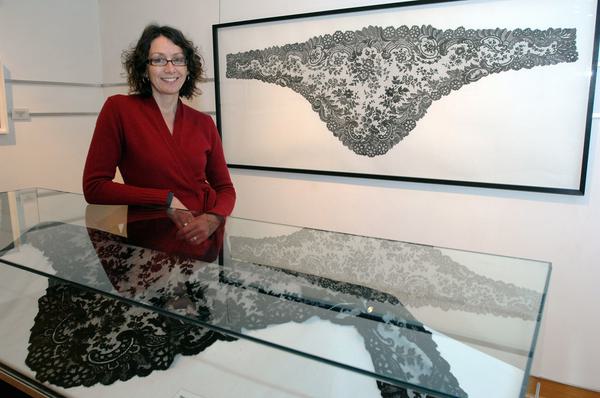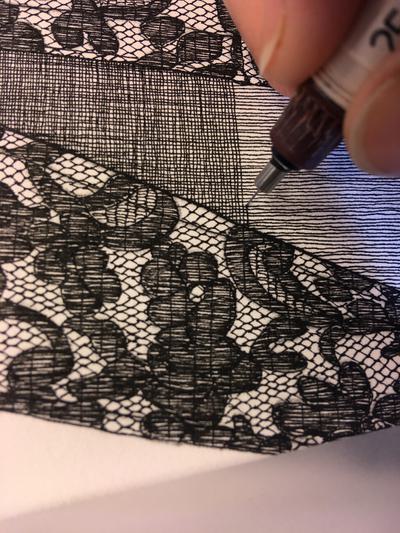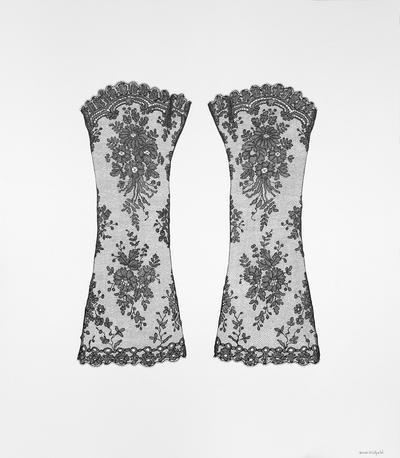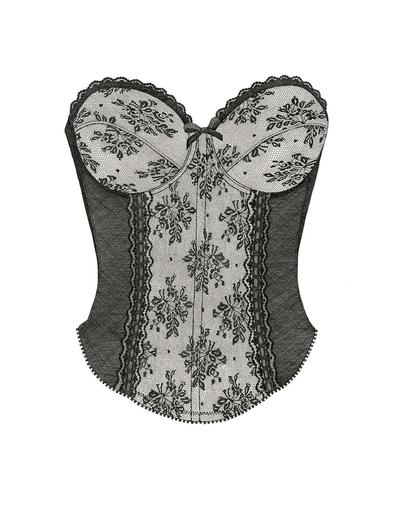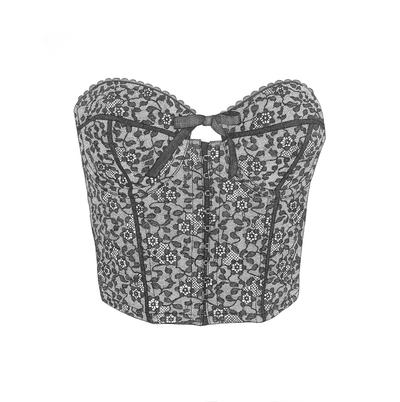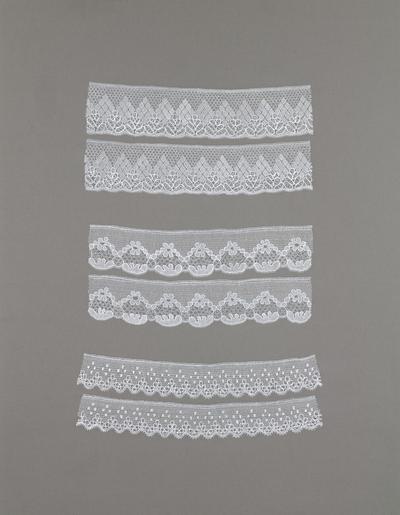Qualifications and Training
1997 - MA Fine Art Drawing, Wimbledon School of Art, London
1987 - BA (Hons) Fine Art Painting, Norwich School of Art, Norwich
1984 - Foundation Art & Design, Maidstone College of Art
Solo Exhibitions
2021 - Lace in Fashion, Museum Intervention, Wardown House Museum, Luton, Bedfordshire
2019 - Tree of Life, Museum Intervention, Killerton House National Trust, Exeter, Devon
2017 - Dentelle et Mode, Museum Intervention, Museum of Lace & Fashion, Calais, France
2014 - Drawing Museum Lace, Salisbury Museum, Wiltshire
2014 - Drawing Museum Lace, Bexhill Museum, East Sussex
2013 - Drawing Museum Lace, Somerset Museum of Rural Life, Glastonbury, Somerset
2009 - Drawing Lace, Worthing Museum & Art Gallery, Worthing, West Sussex
2008 - Drawing Lace, Thelma Hulbert Gallery, Honiton, Devon
Group Exhibitions
2023 - Trinity Buoy Wharf Drawing Prize, London & UK Tour
2023 - Royal Birmingham Society of Artists Drawing Prize, RBSA, West Midlands
2023 - Tailored, Sunny Bank Mills, Farsley, West Yorkshire
2023 - Sussex by Sea, St Mary De Haura Church, Shoreham by Sea, West Sussex
2022 - Essence, 62 Group @60, Alexandra Palace, London
2022 - Essence, 62 Group @60, Harrogate Convention Centre, Harrogate
2021 - Connected Cloth, British Textile Biennial, The Whitaker, Lancashire
2021 - Warp Weft Stitch Thread, Gallery 57, Arundel, West Sussex
2020 - Conversations, St Barbe Museum & Art Gallery, Lymington, Hampshire
2020 - Lost in Lace, Western Exhibition Hall, Ningbo Museum, Ningbo, China
2020 - Lost in Lace, Jiangning Imperial Silk Manufacturing Museum, Nanjung, China
2019 - Body Works, Studio 93a, Brighton Artists Open Houses, Brighton, East Sussex
2017 - Red-Fabrica Peer Group, The Grange, Rottingdean, East Sussex
2015 - Lacemakers, The Stables Gallery, Twickenham, Middlesex
2015 - Mixed Spring Show, Kevis House Gallery, Petworth, West Sussex
2014 - Lace Effects, Museum of Lace and Fashion, Calais, France
2014 - Recent Drawings, Wilson, Stephens Contemporary Art, Notting Hill, London
2013 - IntoLACE, Devon Guild of Craftsmen, Bovey Tracey, Devon
2012 - East Sussex Open, Towner Gallery, Eastbourne, East Sussex
2012 - Lace Works: Contemporary Art & Nottingham Lace, Nottingham Museum
2012 - Wildness Between the Lines, Leeds College of Art, Leeds
2011 - Pulp Fictions, Transition Gallery, London
2009 - Jerwood Drawing Prize, Jerwood Space, London and UK tour
2009 - At Home, K.Montgomery/T.Whitfield, St. Anne's Galleries, Lewes, East Sussex
2008 - HQ Gallery, New Work, Harrogate Art Fair, Harrogate
2008 – HQ Gallery, New Work, Affordable Art Fair, Battersea Park, London
2006 - Summer Exhibition, Royal Academy of Arts, London
2006 - Autumn Exhibition, Royal West of England Academy, Bristol
2006 - Islands Lace, Star Gallery, Lewes, East Sussex
2006 - Star Dust, Star Gallery, Lewes, East Sussex
2001 - Drawings by English Artists, The Tolgarden, Melbu, Norway
1999 - Freeze Frame, Millinery Works, London
1999 - Real, Brighton Media Centre, Brighton
1998 - Lost & Found, Decima Gallery, London and Municipal Markets, Brighton
1992 - In Memoriam, General Cemetery, Sheffield
1989 - 90 Days in 89, Graves Gallery & Mappin Gallery, Sheffield
1987 - Women's Pictures, Maddermarket Theatre, Norwich
Publications
2023 – Pens & Pencils, Ruth Millington, Birmingham Post (19/9/23)
2022 - Significant Figures, Stephanie Bunn, Selvedge Magazine, 105 (pp30-33)
2020 - Drawn to Lace, Ellen Bell, Embroidery Magazine, May/June (pp38-43)
2020 - Lost in Lace, Lace & Lace Making in China, Ningbo Museum, China (YouTube)
2019 - Blue Lace, Jessica Edney, Selvedge Magazine, (09/02/19 blog)
2018 - Lace: a Treasure of Inspiration, Nottingham City Museums & Galleries (film)
2015 - Pilot Project Album, Victoria & Albert Museum Research Institute
2014 - The Visual View, Teresa Whitfield, The North, Spring (pp90-91)
2013 - Lace Here Now, Amanda Briggs-Good, Black Dog Publishing
2012 - Lace Here Now, Elyse Allen, Selvedge Magazine, Nov/Dec, (pp90-91)
2012 - Lace Here Now, Jo Hall, Embroidery Magazine, Nov/Dec (pp8-9)
2012 - Developing the Art of Midwifery, T.Whitfield & J.Hassall, MIDIRS, September (pp32-37)
2010 - Drawing Lace, Teresa Whitfield, Lace Magazine, April (pp14-17)
2009 - Drawing Threads, Teresa Whitfield, Embroidery Magazine, Jan/Feb (pp 16-17)
2009 - Embroidered with White, Teresa Whitfield, Selvedge Magazine, Jul/Aug (p84)
2008 - Long and Drawn Out, Beth Smith, Selvedge Magazine, Nov/Dec (pp48-51)
Prizes, Awards & Membership
2023 - First Prize, Royal Birmingham Society of Artists Drawing Prize, Birmingham
2019 - Membership of the 62 Group of Textile Artists
2018 - Research & Scholarly Activity Award, Northbrook College, West Sussex
2013 - Grants for the Arts Award, Arts Council England
2009 - Artist in Residence, John Grade Elephant Bed, Fabrica, Brighton
2008 - Award for Excellence in Teaching & Learning, University of Brighton
2006 - Teaching Fellowship, Learn Higher CETL, University of Brighton
2002 - Artist in Residence, Brisons Veor, St Just, Cornwall
2002 - Major Award, Arts Council Southern and Southeast
2002 - Research & Scholarly Activity Grant, Northbrook College, West Sussex
2002 - Advanced Practitioner Award, Northbrook College, West Sussex
1994 - Project Award, Yorkshire and Humberside Arts
1987 - Pullen Prize for Painting, Norwich School of Art
Conference Papers / Talks / Panels
2023 - Artist Slide Talk, Bromley Embroiderers, Bromley, Kent
2022 - Artist Slide Talk, West Sussex Art Society, Worthing, West Sussex
2019 - Artist Slide Talk, MA Fine Art, University of Chichester, West Sussex
2017 - Artist Slide Talk, Martlets Lacemakers, Horsham, West Sussex
2017 - External Panel Member, MA Drawing Revalidation, Wimbledon College of Art
2016 - Teaching exchange with Shirley Chubb, MA Fine Art, Chichester University
2015 - Teaching exchange with Tania Kovats, MA Drawing, Wimbledon College of Art
2015 - Re-Considering Historical Lace, Envisioning Lace Study Day, Oxford University Ashmolean Museum
2015 - Re-Considering Historical Lace, Weaving: Making & Thinking, V&A Museum Research Institute VARI, London
2015 - Artist Slide Talk, West Sussex Art Society, Worthing, West Sussex
2014 - Artist Slide Talk, Drawing in Focus Study Day, Fabrica, Brighton
2014 - Re-Considering Historical Lace, DATS Conference, V&A Museum
2014 - Pallant House Interventions, Learning & Teaching Conference, Brighton University
2014 - Artist Slide Talk, MA Fine Art, Chichester University, West Sussex
2014 - Artist Slide Talk, Seawhite Studios, Partridge Green, West Sussex
2012 - Interpretations of Historical Lace, Lace: Heritage & Contemporary Textile Practice Conference, Nottingham Trent University
Teaching
1996 - current Course Leader BA(Hons) Fine Art, Northbrook College, West Sussex
2001 - 2018 PGCE Course Mentor, Northbrook College, West Sussex
